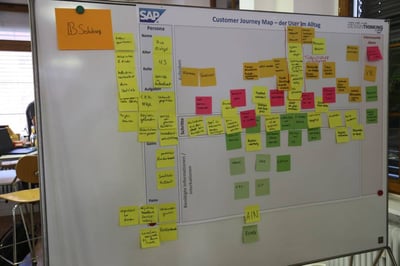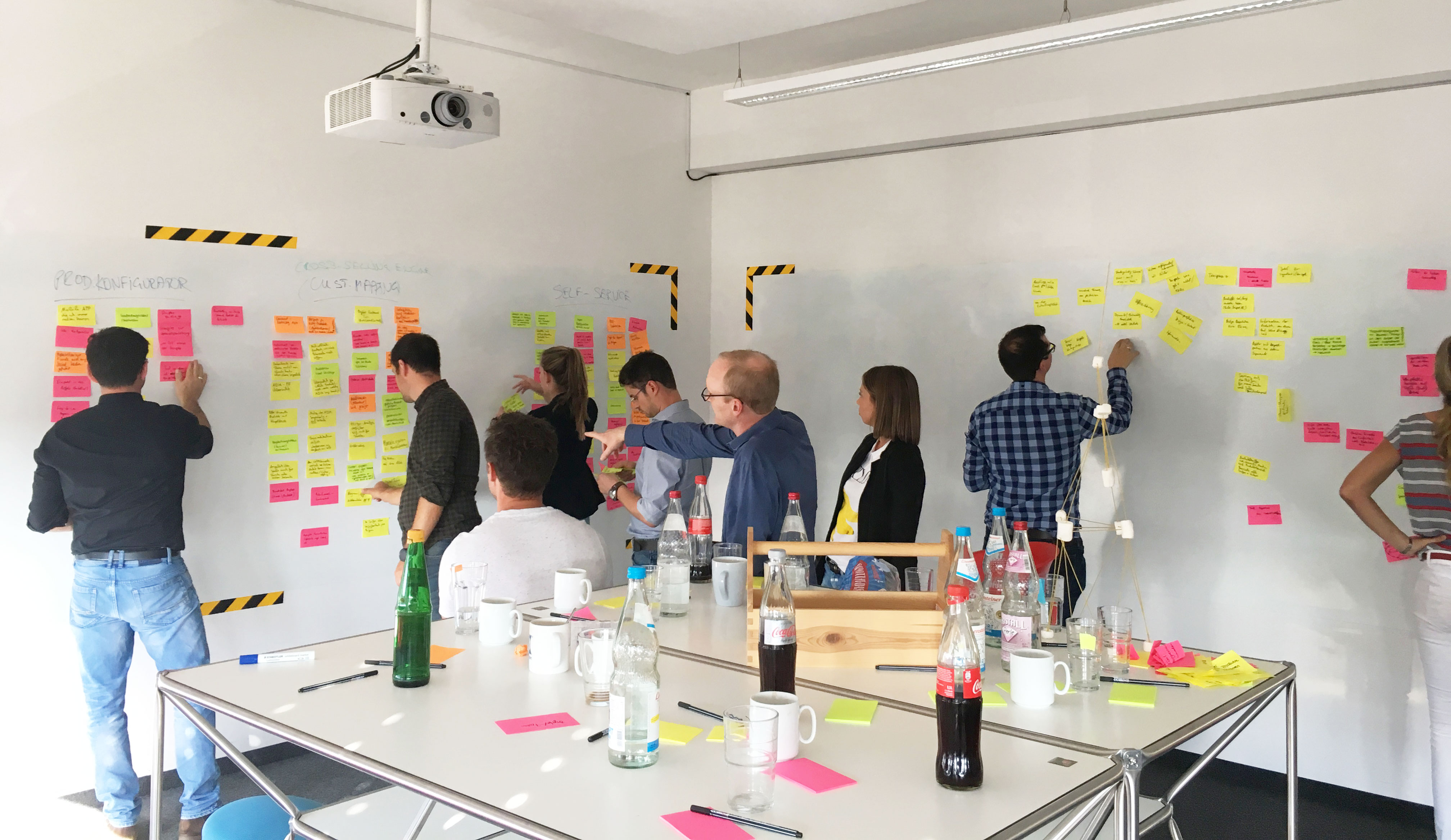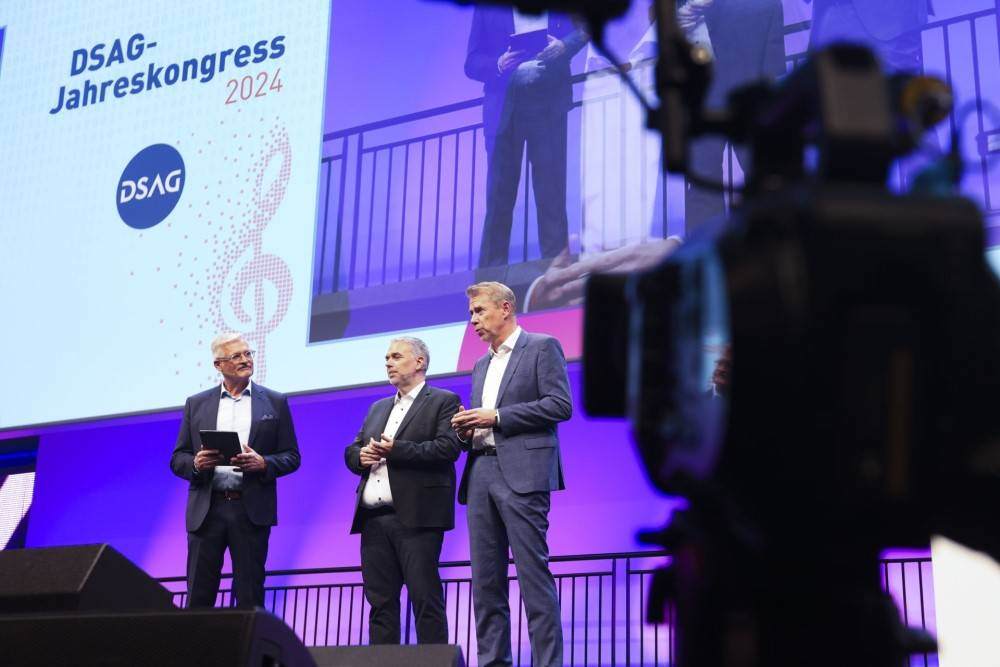Without a doubt, new technologies are the basis for the digital change that is currently shaping the business world. But focusing exclusively on the technological aspect of digitization is not enough. The challenges of the digital age go far beyond technology.
Digitization requires a comprehensive change in the company. For example, a changed mindset and new working methods are important factors in being able to assert oneself in the dynamic and increasingly complex world of work. The motivation, creativity and initiative of employees is required to think beyond departmental boundaries and to pursue innovative paths.
The crucial question that every company must ask itself in the course of digitization relates to its business model. Does it still fit in with the rules of the game of digitization? How should it be changed, if necessary, to ensure future growth? The disruptive nature of digital transformation inevitably puts corporate goals and visions to the test. For companies, this means realignment and optimization.
Together with our clients, we address topics and issues that have been of concern to us as a company for several years. We coach them with regard to the soft skills required for digitalization and work out solutions together that fit their individual requirements. In this way we enable companies to continue to be successful.
At the “Hack2Build - Beyond a Hackathon” event hosted by SAP, participating SAP partners developed side-by-side extensions for SAP S/4HANA. IBsolution presented a showcase that automates administrative workflows in the quotation process through the interaction of SAP S/4HANA, SAP Sales Cloud and SAP Business Technology Platform – and was named the winner of the competition. Thanks to this application, companies can process sales quotations directly without losing time to administrative activities.
To be successful in the digital age, it is not enough to offer the best quality product. Agility, speed and customer orientation create competitive advantages and bind customers to the company. There are no limits to the realization of creative ideas. Technologies such as the Internet of Things (IoT), machine learning and artificial intelligence create new conditions for innovative business ideas and comprehensive analysis options.
There are numerous levers you can turn to make your company fit for digital change. To be fully effective, it is crucial that the individual wheels mesh seamlessly and fit together to form a large whole. That’s why you should combine your measures and procedures in a digital strategy. It provides the answers to how your company wants to be successful and gain competitive advantages in digital markets and gives your employees orientation.
Many of our customers have already implemented optimization measures or innovative business models. You too can benefit from our experience, creativity and implementation expertise.
“We accompany companies on their individual way into the digital future. No matter whether it is a matter of modernizing individual processes or establishing new business models – our team supports you with creative methods in finding ideas, evaluates the technical feasibility and implements. We do digitalization.”
 For innovations to flourish, they need the right environment. Therefore, innovative ideas and digital transformation require a changed corporate culture that is supported by both management and all employees. This includes a leadership culture that creates incentives for creative ideas and new thinking, a suitable working environment (new work), new approaches to problem solving and agile methods that support change in the best possible way.
For innovations to flourish, they need the right environment. Therefore, innovative ideas and digital transformation require a changed corporate culture that is supported by both management and all employees. This includes a leadership culture that creates incentives for creative ideas and new thinking, a suitable working environment (new work), new approaches to problem solving and agile methods that support change in the best possible way.
Set up your company for the future

If you are not able to solve problems with conventional methods, you should try Design Thinking. Although the term is now used in an inflationary way, it still describes a sensible approach to address a problem in (interdisciplinary) teams, to define a problem more precisely and to develop solutions.
Design Thinking is not only a methodology for developers and designers, but can be used in any team constellation. It is important to get involved and be prepared to break new ground. Workshops are a good way to get to know each other and then to dive into a real problem-solving process with enthusiasm. Success will quickly wipe away initial doubts and establish Design Thinking as a permanent method – as most companies that have tried it have done.

Once an idea has emerged from Design Thinking, it can be further developed in small cycles.
In Lean Startup, the idea or product is constantly questioned and verified on the markets. The goal is market success. To achieve this, we need to develop the courage not to think 100%, but to go to market with unfinished products or solutions in order to deploy valuable development resources in a targeted manner and make the best use of commitment.

Business plans were yesterday, today the first steps on the way to a new business model are designed using a canvas. Basically, the Business Model Canvas (BMC) also covers all relevant aspects of a business plan. The difference is that the creation is much faster and we give room to the dynamics of the markets.
Changes in customer segments, sales channels and the characteristics of the product or service can be incorporated quickly so that they do not miss the customer requirements. BMC is available in various forms. It can be used for truly disruptive products as well as for internal changes or making team structures transparent.

“Waterfall was yesterday, agile development is happening today” is a sentence that is often heard. It’s not quite that simple, because choosing the right tool can make the difference between success or failure of the whole project.





Today’s working world would be unthinkable without digital work. Microsoft Teams or Zoom have become standard tools, which not only serve the communication, but also the central know-how development. In addition, online tools such as Mural, Miro and so on are now fully developed. Online meetings using digital whiteboards often prove to be more efficient than face-to-face meetings.
Companies must develop and establish strategies and concepts for digital communication. Communication is the key to agile work organization. With small steps you can already achieve great effects. One example is the creation of a team charter. It defines for temporary or permanent teams the composition, types of communication and other important basics of cooperation.
We would be happy to inspire you and your team in half a day. We define the types of communication together and live the practice from day one. A simple means with great effect to increase the productivity of teams.
Steve Blank, The Startup Owner’s Manual
The challenges of the digital age require smooth interaction between IT and business. Both sides are needed to successfully implement digitization and innovation projects. On the one hand, IT has the central task of ensuring the operation of the existing IT infrastructure. On the other hand, it should also make new technologies available and integrate them seamlessly into the existing architecture. On the other hand, the business department must monitor current market trends and recognize future developments at an early stage. Its field of activity therefore covers much more than classic product innovation.
New, heterogeneous teams have to be created that master the entire range of agile methods and new forms of communication. Projects are carried out differently today than in the past. As a starting point, for example, Design-Led Innovation is suitable for working on a problem with the help of creative ideas. Subsequently, an agile project management ensures that the team makes progress in a short time and that the results of its work are constantly reviewed.
Digitalization is considered a megatrend of the 21st century. It interconnects all areas of life and economic sectors. The digital possibilities are changing the way we live, think and work. Lower investment costs simplify access to digital technologies for companies and make their use increasingly economical. Accordingly, the proportion of digital value added in products and services is rising continuously.
Technological progress and easier availability promote innovation. In the digital age, innovation cycles are becoming ever shorter and their effects ever stronger. Innovations cause disruptions in markets by replacing proven concepts and practices, such as traditional business models and distribution channels.
A characteristic of the disruptive power of digitization is the erosion of traditional industry boundaries. Companies increasingly face competition across industries. Established companies are confronted with competitors that they previously did not even perceive as such. These challenges are not entirely new for companies. However, due to technological development, they have changed considerably in terms of speed and degree of their impact.
Digitization is a time of fundamental change and overrides previous framework conditions. Disruptive technology-based innovations are rendering the traditional business models of established companies and market leaders obsolete. Changing customer requirements and increasing competitive pressure are forcing companies to transform. They must quickly adapt their business models, their organization and their operational processes to the changing conditions of digitalization. In view of rapid progress and ever shorter innovation cycles, it is essential to identify pioneering technologies and business models and to invest consistently in them.
Always up to date



Ideas/inventions can become innovations within several cycles. Adaptation of the original idea and the persistence to continuously improve a product, a service or a process are decisive prerequisites for this.
We distinguish between product/service innovations and process innovations. Processes are optimized, products are made more efficient, better or more economical, so to speak, developed to the maximum. As with IKEA, this can be the shifting of the constructure of furniture to the customer or the shifting of communication from the classic telephone to a mobile device.
If an idea causes fundamental upheaval, it is called a disruptive innovation. Such innovations are capable of “destroying” entire industries or existing products/services/business models and even fundamentally changing the behavior of individuals. One example: The smartphone has transformed our communications in a sustainable way and has been the basis for further innovations.
SAP Business Technology Platform is a central component for today’s IT system landscape and the turbo for your digitalization strategy. Based on SAP HANA in-memory database technology, the solution is offered by SAP as platform-as-a-service and comes with an impressive range of functions. With SAP Business Technology Platform, you can develop, run, and extend highly efficient business applications – much faster and more agile than ever before.
With SAP Business Technology Platform, you can seamlessly connect on-premise and cloud solutions, SAP and non-SAP systems. Provide your employees with a visually appealing, unified system, avoid data silos, and implement smoothly automated processes. SAP Business Technology Platform also lets you choose from a variety of ready-to-use 3rd-party apps that add functionality to your systems. This allows you to develop prototypes and innovative solutions without a long lead time and stay one step ahead of your competitors.
SAP Business Technology Platform supports all major programming languages and has a user interface that is responsive and customizable via the HTML5-based SAP Fiori. With mobile services and security solutions, analysis tools and social collaboration tools, SAP Business Technology Platform creates a foundation that you and your employees will never want to do without. With this solution, you don’t have to worry about data protection. All applications and data on SAP Business Technology Platform are hosted by SAP exclusively in Germany under the highest security and data protection standards.
... you reach a new level of digitalization and networking.
... realize prototypes, new apps and extensions in the shortest time.
... become a pioneer in the field of industry 4.0 and the Internet of Things.
... you don’t have to worry about hardware and infrastructure anymore.
The requirements of the business units in terms of IT are becoming increasingly complex. Users expect an integrated system with a consistent user experience and a central data source. SAP Business Technology Platform enables this process integration across system boundaries and ensures more efficient work without media breaks and application changes.
With SAP Business Technology Platform, you can return to the SAP standard without having to forego personalization and individualization. If you need a specific extension, you no longer need to program it in your core applications. Instead, you develop the functionality in the cloud and connect it to your on-premise systems. Not only does this give you maximum flexibility and save on maintenance and update costs, it also allows you to easily reuse the extensions elsewhere.
The digital transformation and the Internet of Things require more than ever the networking of end devices, sensors, apps, machines, documents, products and much more. SAP Business Technology Platform provides you with a ready-made infrastructure for these challenges and frees you from time-consuming technical preparations. Get started immediately and develop new mobile business applications, innovative customer services, or industry 4.0 scenarios. With SAP Business Technology Platform you can test new concepts instead of just talking about them.



With SAP Internet of Things (formerly SAP Leonardo) and SAP Business Technology Platform, SAP provides all the tools you need to digitize your business and gain a competitive advantage. With our services and technological expertise, we ensure that ideas become reality.
SAP Internet of Things is an integrated system for mapping digital innovations. It integrates pioneering technologies such as Internet of Things (IoT), machine learning, blockchain, artificial intelligence (AI) and big data analytics into SAP Business Technology Platform. In combination with our agile methods for promoting innovative business models, SAP Business Technology Platform also simplifies your path to digitalization.
SAP Leonardo Machine Learning Foundation is the interface and platform for all machine learning applications on SAP Business Technology Platform. Ready-to-use machine learning services are provided for different use cases. The greatest benefit of machine learning is the automation of repetitive activities and a significant reduction in the error rate compared to manual processing. Machine Learning recognizes connections from data that are not recognizable by humans. For tasks such as image classification, machine learning exceeds human capabilities.
The driving force behind the rapidly increasing use of machine learning technologies is big data, which increases the accuracy of machine learning models, increasing computing power, with which ever more complex models and ever larger amounts of data can be evaluated, and neural networks, which develop their own rules instead of using rules defined by humans. In combination with service-oriented architectures and cloud-based solutions, machine learning enables new business models and applications.
Simply fill out the form and send it in. We will contact you as soon as possible.